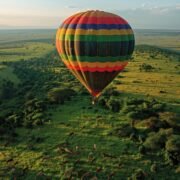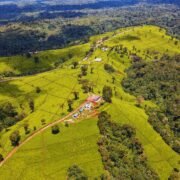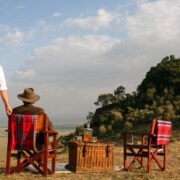
The Costs of an Unforgettable Safari in Kenya: What to Expect and Factors to Consider
Introduction to Safari Costs in Kenya
Embarking on a kenya safari is an extraordinary opportunity to engage with some of the most captivating wildlife on the planet. This unique travel experience allows visitors to explore scenic landscapes, encounter diverse flora and fauna, and connect deeply with nature. However, before setting off on an adventure in the heart of the African wilderness, it is vital to understand the various costs associated with planning a safari in Kenya.
The expense of a safari can vary significantly based on several factors, including the type of safari chosen, duration, accommodation preferences, and additional activities. For instance, a traditional safari jeep excursion through landscapes such as the Maasai Mara can provide an unforgettable experience, while options like a hot air balloon ride over the stunning plains can add a distinctive touch but comes with additional costs. Additionally, factors such as transportation from Nairobi to various parks, including Nairobi National Park, also contribute to overall expenses.
In general, the cost of safaris in Kenya can range from affordable camping experiences to luxurious lodges. Budget travelers may find basic tours starting around $100 per day, while premium safaris can exceed $500 daily, especially during peak seasons. Moreover, as safaris often include comprehensive packages covering accommodation, meals, park entry fees, and guided tours, understanding these aspects is crucial when budgeting for your trip. With a well-planned itinerary, you can ensure a fulfilling experience without overspending.
Ultimately, comprehending the various costs involved in a Kenya safari is imperative for making informed decisions and enjoying your adventure fully. This blog post aims to provide insights into the numerous expenses one may encounter when exploring the breathtaking Kenyan landscapes and its renowned wildlife.
Types of Safaris and Their Price Ranges
Kenya is renowned for its breathtaking wildlife and stunning landscapes, making it a premier destination for various safari experiences. Depending on one’s budget and preferences, safaris in Kenya can be categorized into three main types: budget, mid-range, and luxury. Each type offers distinct amenities and experiences, significantly influencing the overall cost.
Budget safaris are typically the most affordable option. Travelers can expect to pay anywhere from $100 to $200 per person per day. These safaris often include basic camping accommodations or shared lodging in budget lodges. A typical itinerary might encompass guided tours in a safari jeep, with visits to the famous Maasai Mara and Nairobi National Park. Additionally, participants may engage in a few activities such as game drives and perhaps a hot air balloon experience, depending on the package chosen. However, amenities are generally simple, and the focus remains primarily on wildlife viewing.
Mid-range safaris usually cost between $200 and $500 per person per day, providing a balance of comfort and experience. Accommodations include tented camps or lodges offering en-suite bathrooms and hot meals. These safaris often provide tailored experiences, including a well-organized Nairobi city tour and options for hot air balloon rides that can elevate the safari experience to new heights. A mid-range safari generally includes more personal attention from guides, allowing for a deeper appreciation of the diverse wildlife and ecosystems found in locations like the Maasai Mara.
Luxury safaris, on the other hand, can range from $500 to over $1,500 per person per day. These exclusive experiences offer high-end lodges or permanent luxury tents equipped with gourmet meals and private guides. Guests can partake in tailored activities, including private game drives in a spacious safari jeep, ensuring optimal comfort and service. Specialized experiences such as private hot air balloon safaris with champagne breakfasts can significantly enhance the adventure, making luxury safaris an unforgettable choice for those willing to invest.
Factors Affecting Safari Pricing
The cost of a Kenya safari can vary significantly based on several key factors. Understanding these elements is essential for travelers looking to plan an unforgettable experience. One of the primary aspects is seasonality. The peak season, typically occurring between June and October, sees an influx of tourists eager to witness the Great Migration in the Maasai Mara. During this time, prices for safari packages can surge due to high demand. Conversely, visiting during the low season may offer lower rates, albeit with fewer wildlife sightings.
Location also plays a crucial role in determining safari costs. For instance, the Maasai Mara is known for its abundant wildlife and breathtaking landscapes, leading to higher rates. In contrast, Nairobi National Park, while offering its own unique blend of urban wildlife experience, generally features different pricing structures. Travelers may opt for a Nairobi city tour combined with a short safari in the park, affecting overall costs.
The level of luxury chosen will undoubtedly influence pricing as well. A budget safari in a shared safari jeep can provide a wonderful experience, but for those seeking a more lavish experience, luxury lodges or private tours may be more appropriate. Group size is another contributing factor; private safaris are typically more expensive per person compared to group safaris. Lastly, the length of the safari also directly impacts the pricing, with longer safaris generally costing more due to extended accommodations, meals, and transport. As such, planning ahead and considering these factors will aid in crafting the ultimate Kenya safari adventure tailored to individual preferences and budget constraints.
Accommodation Options and Their Costs
When planning a kenya safari, one of the most significant expenses is accommodation. The choices available to travelers vary widely, and understanding these options can enhance your safari experience immensely. Here, we explore the various types of accommodations, namely lodges, tented camps, and camping sites, all of which cater to a range of budgets and preferences.
Lodges are often the most luxurious form of accommodation in safari destinations. Found in prime locations such as Maasai Mara and Nairobi National Park, these establishments typically offer well-furnished rooms, dining facilities, and guided safari jeep tours. Prices for lodges can range from mid-tier at around $150 to $600 per night, depending on the level of luxury and the specific lodge’s amenities. Some of the high-end lodges even include exclusive experiences like hot air balloon rides at dawn, allowing guests to witness the breathtaking spectacle of wildlife from above.
Tented camps serve as a middle ground between budget-friendly and luxury options, providing a unique and authentic encounter with nature. Generally located within or near game reserves, these camps offer comfortable accommodation with shared or en-suite facilities. Prices for tented camps can vary from $80 to $400 per night. Many offer guided tours and activities as part of the package, which can include night safaris, bush dinners, and cultural interactions with the local Maasai community.
For those looking to minimize costs, camping sites provide the most economical approach to a kenya safari. Often found within national parks or private conservancies, these sites allow travelers to experience the bush up close. Costs typically range from $20 to $100 per night for a basic setup, which might include shared restrooms and limited amenities. Camping can be an exhilarating option, especially for adventurers seeking a more rugged experience, where the sounds of wildlife form a natural backdrop.
Each accommodation option presents unique advantages and costs that reflect the level of comfort and experience offered. Selecting the right one depends on personal preferences, budget limitations, and the overall experience one desires during their safari adventure.
Transport and Logistics: Costs to Consider
When planning a kenya safari, one essential aspect to consider is transportation. The choice of transport not only affects the overall safari experience but also significantly impacts the budget. Travellers often have several options to consider, including private vehicles, shared vans, and flight transfers, each with its own cost implications.
Private safari jeeps offer a personalized experience, allowing for flexibility in planning itineraries and schedules. However, this luxury comes at a premium, with costs often including fuel, driver fees, and potential additional charges for park entry fees. Prices can vary greatly depending on the size of the vehicle and the length of the safari, with well-equipped safari jeeps costing more due to their specialized features suitable for rugged terrains.
Shared vans provide a more economical option for those looking to minimize costs. This mode of transport not only divides the fare among passengers but also includes the added benefit of social interaction with fellow travellers. While this option may reduce expenses, it may limit some aspects of the safari experience, such as deciding when to stop for wildlife viewing.
For those wanting to cover larger distances quickly, flight transfers to destinations like Maasai Mara from Nairobi National Park may be an attractive choice. However, such flights typically come with a higher price tag, which can significantly impact the overall budget of the safari. Additionally, one must consider the logistics of transfers to and from airstrips, which may require a vehicle or van arrangement.
Ultimately, understanding the costs associated with different transportation modes allows travellers to make informed decisions that align with their preferences and budget. By carefully considering these factors, safari enthusiasts can ensure a memorable and well-organized kenya safari experience.
Extra Costs: Tours, Guides, and More
When planning a kenya safari, it is important to consider not only the basic costs of accommodation and transportation but also the potential extra expenses that can enhance your overall experience. One significant factor that contributes to these additional costs is the guided tours. Opting for a knowledgeable guide can greatly enrich your safari experience, as they provide valuable insights and help in spotting wildlife that you might otherwise miss. Guided tours can vary in price depending on the level of expertise and the duration of the safari.
Another popular activity that adds to the overall cost is the hot air balloon ride over the stunning landscapes of the Maasai Mara. This unique experience allows you to view the savanna from an entirely different perspective and witness the breathtaking beauty of the wildlife below. However, it comes at an extra fee, which should be factored into your total travel budget. The cost of a hot air balloon ride typically includes a safari jeep transfer to the launch site, a breakfast after the flight, and sometimes even champagne to celebrate the experience.
Additionally, visitors should be aware of entry fees for Nairobi National Park and any other parks you plan to visit. These fees can vary significantly and may depend on whether you are a resident or a non-resident. Knowing these costs ahead of time will help you better manage your finances during your trip. Furthermore, it’s common to tip safari guides and drivers as a sign of appreciation for their services. Although not mandatory, tipping is generally expected and can vary based on the quality of service received.
By considering these extra costs—guided tours, special activities like hot air balloon rides, park entry fees, and tips for guides—you can better understand the financial commitment required for an unforgettable kenya safari experience. Planning and budgeting for these aspects will ensure your trip is both enjoyable and memorable.
Budgeting Tips for Your Kenyan Safari
Planning a safari in Kenya can be an exhilarating adventure, yet it is essential to consider budgeting to ensure a memorable experience without financial strain. One of the first steps in your financial planning should be to research the costs associated with key activities such as hot air balloon rides over the Maasai Mara, excursions in Nairobi National Park, or guided tours around Nairobi city. Each of these experiences has varying costs, and prices can fluctuate based on the season.
To prioritize spending, identify the activities that are most important to you. If witnessing the wildlife migration in the Maasai Mara is your ultimate goal, allocate a larger portion of your budget towards that. Consider investing in a safari jeep, which offers a more immersive experience than large tour vans, allowing for closer interactions with nature. Being strategic about when and how you book activities can also impact your overall budget significantly. Utilize early bird discounts or look for package deals that combine multiple services.
Finding the best deals often means exploring multiple sources for information. Consult reputable travel agencies or use online platforms that specialize in safari bookings. Personal recommendations from previous travelers can also lead to valuable insights and potential cost savings. Additionally, consider traveling during the shoulder seasons when prices may be lower, and crowds are thinner, allowing for a more personal experience without sacrificing quality.
Balancing costs with experiences is crucial to maximizing enjoyment during your Kenyan safari. It’s essential to set a budget but remain flexible; spontaneous opportunities can lead to the most memorable moments, such as an unexpected sighting of wildlife or a last-minute hot air balloon ride. By being mindful of your spending while ensuring you experience the magic of Kenya’s landscapes and wildlife, you can create an unforgettable adventure on your safari.
Comparing Safari Packages: What to Look For
When planning a kenya safari, one of the most critical steps is to compare various safari packages available to ensure that you maximize your experience while staying within your budget. The first element to consider is the inclusivity of meals. Many safari packages offer full board, which typically includes breakfast, lunch, and dinner, allowing travelers to indulge in traditional cuisine and local flavors. However, some packages may only cover certain meals or leave you to fend for yourself during the day, particularly when on excursions such as a hot air balloon ride at Maasai Mara. Understanding what is included can significantly affect your overall budgeting.
Daily activities included in the safari package are another vital factor. Different packages may offer varied activities such as guided safari jeep tours or cultural visits to Maasai villages. Additionally, consider whether the itinerary allows flexibility or free time to explore on your own or embark on a Nairobi city tour. This can enhance your experience and allow you to engage more deeply with Kenya’s rich culture and wildlife.
Accommodation quality also plays a significant role in selecting the right safari package. Accommodations can range from luxurious lodges to basic tented camps, each providing a different level of comfort and amenities. Determine your preferences for amenities such as en-suite bathrooms, hot water availability, and proximity to wildlife viewing areas. This choice will heavily influence your level of comfort during your kenya safari.
As you evaluate these elements, it is crucial to consider your personal preferences and financial limitations. By taking the time to compare the inclusiveness of meals, the variety of daily activities, and the quality of accommodations, you will be better equipped to choose a safari experience that aligns with your expectations and budget, ultimately ensuring an unforgettable adventure in the heart of Kenya.
Conclusion: Making an Informed Decision
As you consider embarking on a journey through Kenya, understanding the costs associated with an unforgettable safari experience is crucial. From the breathtaking wildlife in the Maasai Mara to the dynamic landscapes of Nairobi National Park, a well-planned safari not only captivates but also delivers unforgettable memories. Various factors influence the overall expenses, including accommodation types, travel logistics, and activities such as hot air balloon rides over the savannah or guided tours in a safari jeep or van.
Establishing a clear budget is the first step towards enjoying a Kenya safari that aligns with your financial expectations. Evaluate various accommodations ranging from luxurious lodges to more modest options that offer comfort without compromising on experience. Additionally, consider your transportation preferences, whether it be a comfortable safari jeep or a spacious van, as these choices will impact your overall budget.
Furthermore, incorporating activities like a Nairobi city tour or a hot air balloon adventure can enrich your experience but may require additional financial planning. It is advisable to research thoroughly and compare different packages offered by various tour operators. Pay attention to client reviews and the reputation of agencies to ensure a promising experience.
Ultimately, the goal is to create a memorable adventure that fits within your means while allowing you to fully immerse yourself in the rich culture and wildlife of Kenya. By factoring in the various components such as costs, accommodations, and activities, you can make an informed decision that ensures your Kenya safari is a remarkable journey, tailored perfectly to your desires and budget.






